Introduction
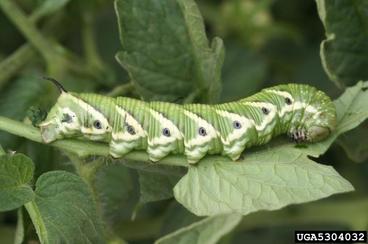
The tomato hornworm, Manduca quinquemaculata (Lepidoptera: Sphingidae), is native to the United states, and is commonly found throughout the northern states. This insect does not typically reach economically damaging levels on commercial farms. However, large numbers of larvae can sporadically occur in home gardens. Tomato hornworms feed only on solanaceous plants, most often on tomato. However, larvae will also attack eggplant, pepper, and potato. There are many solonaceous weeds that also serve as alternate hosts, including: horsenettle, jimsonweed and nightshade. There are usually 2 generations of this insect each year in the upper Midwest.
Biology
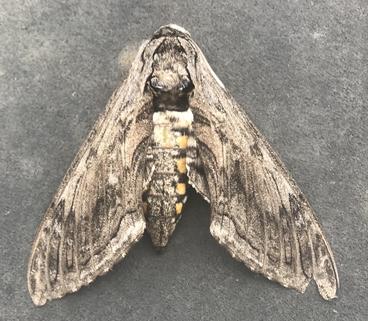
The adult moth, sometimes referred to as a "sphinx", "hawk", or "hummingbird" moth, is a large, heavy-bodied moth with narrow front wings. The moth is a mottled gray-brown color with yellow spots on the sides of the abdomen and a wing spread of 4 to 5 inches. The hindwings have alternating light and dark bands.
Eggs of the tomato hornworm are deposited singly on both the lower and upper surface of leaves in late spring. The eggs hatch in six to eight days and are oval, smooth, light green to yellow in color, and measure 0.10 cm in diameter.
Larvae are pale green with white and black markings (see photo), and undergo 5-6 instars. The first instar is yellow to white in color with no markings. Later instars develop eight white, lateral "V-shaped" marks. A black projection or "horn" on the last abdominal segment gives the caterpillar the name "hornworm."
The caterpillar reaches the final instar in 3-4 weeks, and is 3 1/2 to 4 inches when fully mature. Fully-grown larvae then drop off of the plants and burrow into the soil to pupate. During the summer months, moths will emerge from pupae in about 2 weeks. Moths emerge from the soil, mate, and then begin to deposit the eggs of the next generation on tomato plants. By early fall, the pupae will remain in the soil all winter and emerge as a moth the following spring.
Damage
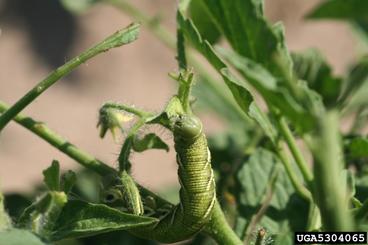
The larva is the damaging stage and feeds initially on the upper portions of leaves, leaving behind dark green or black droppings. The larvae blend in with the plant canopy, and therefore go unnoticed until most of the damage is done. Late instar larvae are capable of destroying several leaves as well as the fruit. As the larvae mature in size the amount of defoliation increases, with the last instar consuming over 90% of the total combined foliage consumed by all instars.
Management Options
Cultural Control
Handpicking the hornworms from infested plants is a safe and effective option in smaller plantings. Roto-tilling the soil after harvest will destroy many of the burrowing larvae which are attempting to pupate. Tillage has shown to cause up to 90% mortality.
Biological Control
There are many natural factors that help to control tomato hornworm infestations. The egg stage and early instar larvae are often preyed upon by various general predatory insects such as lady beetles and green lacewings.
Tomato hornworm larvae are also parasitized by a number of insects. One of the most common is a small braconid wasp, Cotesia congregatus. Larvae that hatch from wasp eggs laid on the hornworm feed on the inside of the hornworm until the wasp is ready to pupate. The cocoons appear as white projections protruding from the hornworms body. If such projections are observed, the hornworms should be left in the garden to conserve the beneficial parasitoids. The wasps will kill the hornworms when they emerge from the cocoons and will seek out other hornworms to parasitize. Another important natural enemy is the predatory wasp, Polistes spp. (Hymenoptera: Vespidae). This common wasp kills and feeds upon a large proportion of the larvae, and will also attack cabbage looper and other garden caterpillars.
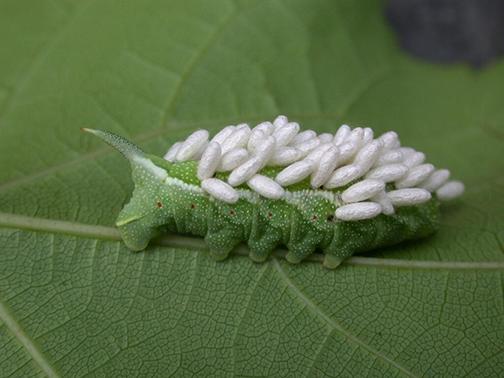
Tomato hornworm parasitized by Cotesia sp. (E.C. Burkness, UMN).
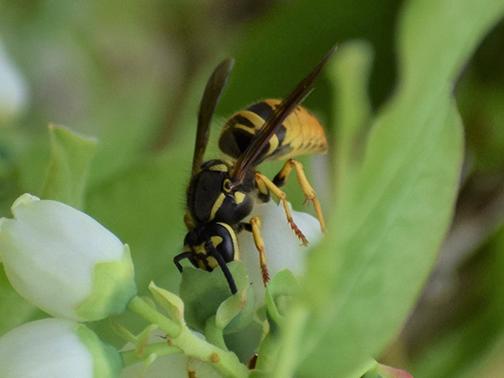
Polistes spp., a predator of tomato hornworm (S. Wold-Burkness, UMN).